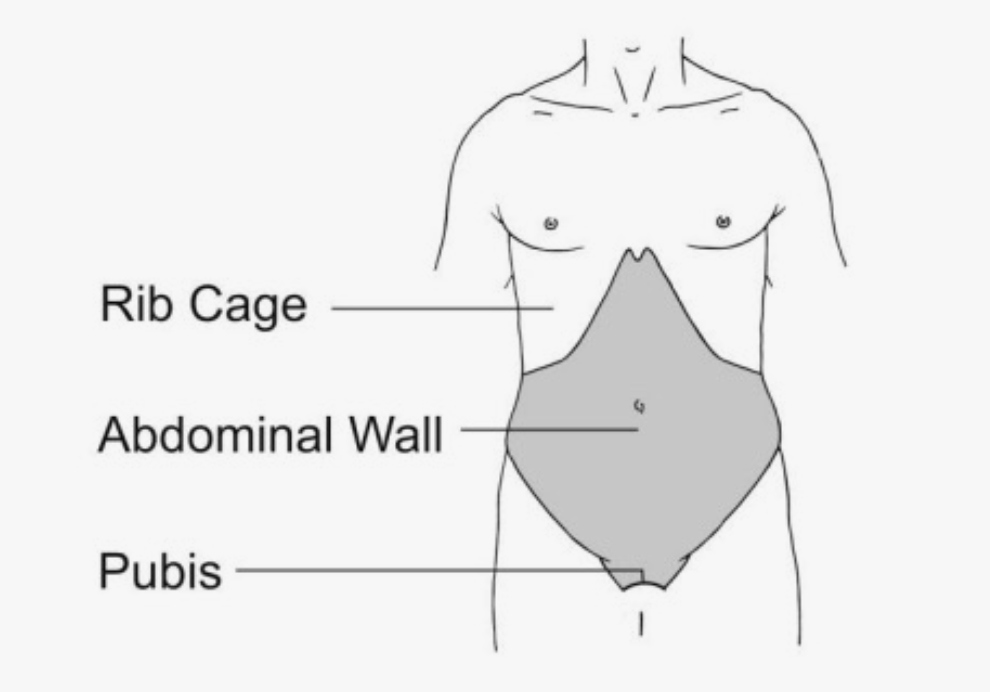Abdominal wall reconstruction is the practice of rebuilding the front of your abdomen, which has been affected by hernia disease. Abdominal wall reconstruction is the practice of taking a dysfunctional abdominal wall due to hernia disease and putting it back together using advanced surgical techniques. Abdominal wall reconstruction is reserved for large, more complex, or recurrent hernias.

The Abdominal Wall
The abdominal wall is one of the most complex anatomical structures in the human body. Each of the muscles interconnect with each other, and the function of the abdominal wall is dynamic and complex in nature.
The major muscles that we attempt to reconstruct are the:
- Rectus abdominis
- External oblique
- Internal oblique
- Transversus abdominis
What is the function of the abdominal wall?
The group of muscles have their own blood supply and nerves. Together they create a strong structure which supports the internal organs. They also help in providing abdominal pressure when needed e.g. in breathing out, coughing and emptying bowels.
What is an abdominal wall hernia?
A hernia of the abdominal wall is a bulging of the abdominal contents through an area of weakness in the wall. An abdominal wall hernia can be small and simple or large and complex. Many hernias do not cause symptoms, but some may cause pain. If you have symptoms like pain and you would like your hernia repaired then we can consider this. However, you must be fit enough for surgery.
What is complex abdominal wall hernia?
A complex hernia is usually one which the hernia hole is more than 10cms in size. Depending on the size and nature of the hernia and the strength of your abdominal wall you may need complex surgery. These hernias often occur through the incision of a previous abdominal operation. This is then known as an incisional hernia.
How is abdominal wall surgery performed?
Abdominal wall surgery may be performed using:
- An open technique with traditional incisions
- Laparoscopic technique using small incisions
- Robotic technique using small incisions
Small incisions are generally preferred, but there are often reasons that make an open approach better, such as the difficulty in closing incisions, or the need to remove redundant tissue or skin.
There are several surgical procedures that fall under the category of reconstruction.
These include:
Retro-rectus Rives Stoppa repair
This involves cutting the connective tissue, or fascia, around the abdominal muscles to flatten them and bring them together.
This technique attempts to re-approximate your rectus abdominis muscles and repair the hernia at the same time. Mesh is placed behind your abdominal muscles.
Anterior component separation
This surgery involves making a cut in one of your oblique muscles (the external oblique) so that your hernia can be repaired without tension. The incision into that muscle has no meaningful affect on your future core function after you heal.
Posterior component separation, or Transversus Abdominis Release (TAR)
This involves cutting the transversus abdominis muscle, the innermost of our oblique muscles.
This surgery is more complex than the Rives-Stoppa techniques, in that to assist with closing large hernia defects, a cut is made in one of your oblique muscles (the transversus abdominis) so that your hernia can be repaired without tension. This incision into that muscle has no meaningful affect on your future core function after you heal.
Mesh and abdominal wall reconstruction
There is much conversation regarding mesh in the media, mostly stemming from lawsuits regarding mesh for vaginal slings. In abdominal wall surgery, permanent or semi-permanent mesh has been proven through multiple studies to drastically reduce the risk of recurrence in the future, as it assists with scar tissue formation to form your “new” abdominal wall.
There is always a risk of synthetic or biologic mesh complications, such as infection, erosion, or chronic pain. These risks can be reduced by placing the mesh in a space which has no contact with bowel and using techniques which do not expose any abdominal wall nerves. This provides a natural barrier between any intestine and the mesh.
What factors make me fit for abdominal wall reconstruction surgery?
Fitness for surgery depends on many factors. You may need to be assessed by an anaesthetist before your surgery. They will take into account your physical fitness, for example; how far you can walk and your medical co-morbidities.
Factors which you can change before your surgery (and will greatly reduce the risk of surgical complications) include:
- Being a non-smoker
- Having a body mass index (BMI) less than 35
- Having a good diabetic control (if you suffer with diabetes). This equates to HbA7c of 7% or <53mmol/ mol or average blood glucose of 8.5 or less
What investigations are necessary before undertaking abdominal wall reconstruction surgery?
You will need to have either a CT or MRI scan before surgery.
How long does complex hernia surgery take?
This is very variable depending on the patient. It can be a very long operation but once the surgery has begun, it can be more straightforward than expected. Conversely, some patients have more bowel adhesions scar tissue than appear on the CT scan and therefore surgery can take longer than first expected.
On average, complex abdominal wall reconstruction surgery can take between two to six hours to complete depending on the complexity of the individual case.
How long does it take to recover from abdominal hernia surgery?
In terms of recovery from complex abdominal wall surgery. Generally, the recovery time required is very variable and often depends on the physiological fitness of the patient. On average, patients spend up to a week in hospital following surgery.
Once patients start to mobilise again, some are up and about within a month but others may take longer than that. If the operation is shorter then recovery will be quicker. But a longer or more complex operation can have a longer recovery.
When you see Mr Lingam he will advise you which hernia repair will be appropriate.
Contact us
Should you wish to consult Mr Lingam about your hernia, please send an email to mklingam.sec@gmail.com or call:
Derby Nuffield on 01332 540100
Derby Private Suite on 01332 786128
Mr Lingam consults at the Derby Nuffield on Tuesday AM, Wednesday and Friday PM and at Derby Private Suite on a Thursday PM.
